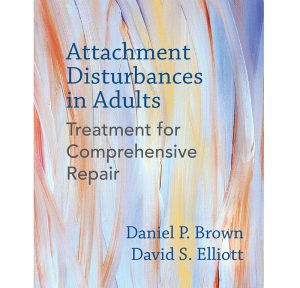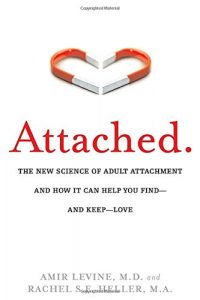There are two common issues I see in my sex therapy practice: sex and anxiety issues and sex and attachment issues. Generally all clients that I see come to me with one or both of these issues, and often times they are the core and fundamental route of other sexual and relationship issues that I see in my work.
I recently attended a training presented by David S. Elliot, PhD on “Healing Adult Attachment: The Three Pillars of Integrative Treatment”. He is one of the authors of Attachment Disturbances in Adults: Treatment for Comprehensive Repair which details in depth a lot of the concepts presented here around attachment issues in adults. A lot of this blog comes from the information in his book as well as the presentation and information along the way of being at sex therapist for over 10 years. I will specifically attend to the issue of how I am seeing SEX and attachment present itself in my therapy practice. Attachment concerns aren’t a DIY fix- it requires a skilled and trained therapist to take clients to a depth of repair that needs care, nurturance and support. This book is a big one, thick and cerebral, and something that presents as an invaluable amount of information and resources for the type of therapy that I do.
What is adult attachment?
Watch this brief video on modern adult attachment to learn more about adult attachment.
Attachment affects everything that we do. Attachment insecurities underlie a lot of mental health problems. If we treat the attachment issue, we can treat the underlying issue for a lot of mental health issues.
Characteristics of Adult Attachment Patterns
Here are a list based on Elliot’s (2018) presentation handouts of the four main types of attachment styles. Read through the description and see where you fall.
Secure Attachment
Seeks emotional closeness with others
Able to establish emotional intimacy
Comfortable with mutual dependence
Comfortable being alone
Positive self-image and other image
Warm and open with others
Accepts criticism without significant distress
Strong sense of self
Self-esteem
Self-observational skills
Self-reflective skills
Able to trust in relationship
Relationships tend to be stable, lasting
Open with others about feelings
Positive feelings about relationships
Balanced experience of emotions – neither too little nor too much Values attachment
Dismissing Attachment
Avoidance of getting close or being intimate
Discomfort with closeness
Ambivalence
Dismissing behaviors
Aloofness and contempt
Mistrust about depending on others
Difficulty getting close
Preference for remaining distant
Fearful of closeness
Unemotional or minimizing emotional expression
Uncomfortable opening up, especially private thoughts
False self
Pulls away if someone gets close
Illusion of self-sufficiency
Anxious-Preoccupied Attachment
Excessive worry about relationships
Worry that one’s partner won’t care as much as s/he does
Obsessive preoccupation and rumination about relationship
Excessive need for approval
Ignoring signs of trouble in the relationship
Fear of scaring people away
Fear of abandonment/rejection/criticism
Resentment when partner spends time away from the relationship
Angry withdrawal
Frustration if partner not available
Feels extremely upset/depressed when receives disapproval
Easily upset, with intensified displays of distress or anger
Jealousy
Fear of being alone
Compulsive caretaking
Submissive, acquiescent, suggestible
Seeks attachment at the expense of autonomy
Work, school, or friends get less attention than relationship partner
Compulsive care-seeking
Partner describes self as ‘smothered’ or ‘suffocated’
Eager to be with partner all the time
Needs excessive reassurance
Clinging, demanding, nagging, sulking
Desire to merge
Attempts to win favor or impress
Forces responses from partner
Self-centeredness, showing off, center of attention.
Disorganized Attachment
Combinations of behaviors from the two insecure types above
Disorganized internal world
Dysregulated psycho-physiological state
Affect dysregulation (too much or too little)
Lapses in self-observation or monitoring
Discontinuous self-states and affect states
Cognitive distortion, confusion, and drive-dominated thinking
Disorganized behavior
Impaired self-agency and goal directed behavior Inhibition of exploration and play
Disorganized attachment behavior
Activation of contradictory attachment strategies Controlling behaviors
Submissive or excessive care-taking behaviors ‘Stable instability’ in relationships
Defensive aggression and helplessness
Inability to elicit desired responses from others
Individual Treatment for Adult Attachment Issues
My clients often ask- how can you help me? What will treatment look like? Especially with attachment issues, my clients often feel like there is nothing that can be done to change me and/or my partner. Using a specified attachment treatment model, there are three components in attachment-based treatment (this might be above a lot of heads, but it gives you an idea that there is actually a method to our madness as therapists):
- Creating new positive attachment representations (Internal Working Models- IWMs) with the Ideal Parent Figure (IPF) Protocol
- Enhancing metacognitive ability and functioning
- Cultivating collaborative skill and behavior
- Treatment frame behavior
- Nonverbal collaborative behavior
- Verbal collaborative behavior
In therapy with me, we will attempt to resolve many of the attachment issues by building a securely attached relationship with the therapist as a spring board to developing healthy attachment with others. I have the principle that therapist is a good attachment figure that can co-collaborate with the client to create a healthy attachment. I create the condition for the client to feel safe, to bring to me what you may never have told anyone before, and we want to create that fertile ground for a client to be able to develop health attachments to us as the therapist and beyond.
Relationship Treatment for Attachment
I see a lot of couples that have mismatched attachment systems. It’s estimated that approximately 50% of the population has secure attachment, approximately 25% each have anxious/preoccupied and dismissive/avoidant respectively, and somewhere in that approximation, 3% have the disorganized style. Where I see this the most challenging in couples and relationships is when one person(s) has an “insecure” type (anxious/preoccupied, dismissive/avoidant, and disorganized) and one person(s) is secure. More challenging and with more inflammation within the relationship is the anxious/preoccupied is paired up with a dismissive/avoidant. These relationships tend to feel super stuck and completely unresolvable, but they are improvable as we work towards moving both partners towards a more secure relationship attachment style through some individual and relationship work mentioned above. The first step is awareness of your own attachment insecurities and style and then of your partners, recognizing that it isn’t your partner intentionally doing things that stress or activate your attachment systems, but rather them acting within their own attachment style based on their development of attachment long before you ever came into the picture.
Sex and Attachment
How do our attachment styles, challenges and strengths, affect us sexually. This is an interesting question, and to answer it, I’m going to reference a 2013 study on “The Associations Among Adult Attachment, Relationship Functioning, and Sexual Functioning”“The Associations Among Adult Attachment, Relationship Functioning, and Sexual Functioning”, a blog entitled “Personality in the Bedroom” by Susan Krauss Whitbourne and a 2002 study on adult attachment and sexual behavior.
I’m also going to share some personal experiences with 10+ years in practice as a licensed marriage and family therapist and AASECT certified sex therapist. Since this issue is one of the most common issues I confront in my practice, I see a lot of individuals and relationships where their attachment styles negatively and positively impact the sexual part of their relationship.
Anxious/Preoccupied: Sex and Attachment
Based on the research and my own findings, I find that people with anxious/preoccupied attachment styles often value sex more as a barometer of how their relationship is going and how valued they are in a relationship. And if sex isn’t happening, it can highly activate an anxious/preoccupied attachment disturbances because they don’t feel loved, secure, or valued without that measure of their “okay”-ness. Anxious/preoccupied seek out sex to connect with their partner, and depending on the reaction of the partner, this can often work in the exact opposite way the anxious/preoccupied wants: it actually pushes the avoidant/dismissive partner away.
Avoidant/Dismissive: Sex and Attachment
People with an avoidant attachment style tend to avoid intimacy, be emotionally withdrawn, and try to be more self-reliant, including in sexual matters. They report lower sexual satisfaction and often move away from sex more, especially if it doesn’t go exactly as planned. If sex and their sexual value is tied to their self worth, avoidants will often feel very strongly when sex doesn’t go the way it “has in the past” or the way they expect it to go. This can lead to avoidance of sex and intimacy, or blaming of their partner. Here are some more “Sexual Symptoms of Avoidant Attachment“.
If you want to read more about attachment style and how it relates to sexual satisfaction, Psychology Today published an article entitled “How Attachment Style Affects Sexual Desire and Satisfaction“.
While there is a lot more to say about sex and attachment, these are just a few of my thoughts, much better explained in I’d highly recommend this book Attached by Amir Levine and Rachel Heller.


